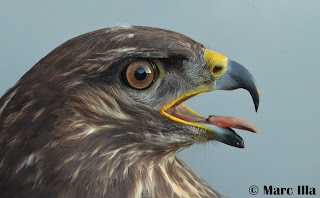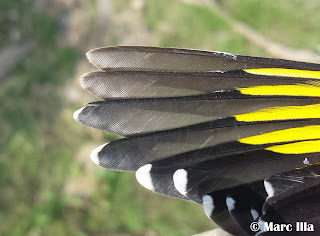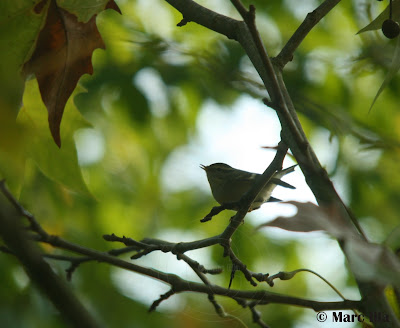Even the cold hasn't really arrived, late December it's the actual beginning of what we call winter. If I had to briefly define how the winter is around my area (central Catalunya), it would be something like:
- good numbers of Robins (Erithacus rubecula) and Dunnocks (Prunella modularis)
- quite good winter for Reed Buntings (Emberiza schoeniclus) and for Dartford Warbler (Sylvia undata)
- low numbers of finches (starting with Chaffinches Fringilla coelebs, but especially poor for Siskin Spinus spinus, Hawfinch Coccohtraustes coccothraustes, and of course Brambling Fringilla montifringilla)
- low numbers of thrushes too, especially Song Thrushes (Turdus philomelos)
These are just impressions that I got from the local birding in the area and several small projects in different localities, and also some information shared with friends. These 'characteristics' of the winter are the ones that make me focuse more or less in one thing or another. For instance, the Siskin feeder at Jaume Tarín's place has very low numbers this year, and we will make much less attempts to ring there. Indeed, after several sessions of more than a hundred Siskins caught, this year it seems that only from 5 to 10 birds are around the area.
Most of seasonal trends I get every year come from the constant ringing and birding in my main local patch, l'Aiguamoll de la Bòbila. During this year, some interesting new species have been caught in the ringing station, two of them during this autumn: Common Buzzard (Buteo buteo) and Goshawk (Accipiter gentilis).


Ather local project that I have been working with for the last years is the Reed Bunting roosting project. As I said, this year seems to be one of the best winters since I start in 2013, with around 100 birds roosting in the biggest site, and about 70 between the other two roosting sites in the area. With the migrants during October and November, I have ringed more than 300 individuals and recovered a good set of birds from previous years, 3 foreign recoveries (1 Finnish and 2 French), and an interesting amount of individuals caught in different places during the same or different winters.

Right at half of the season, it is already noticeable the relative high proportion of males caught, but still females are more abundant. Also, it seems that during this season I have trapped more 'unusual sized' birds, with some rather small males and big females. For instance, this small male (pictures below) was only 77mm on wing length!
Dartford Warblers (Sylvia undata) have appeared too in places where they are usually very rare and almost only as migrants, and in quite good numbers in the traditional wintering areas. It was very nice to trap this first-winter (EURING 3) in the Reed Bunting roosting site!
The Alpine Accentor (Prunella collaris) project is still on, and with the collaboration from the Montserrat Mountain Natural Park and the Catalan Ornithological Institute (ICO), this year I have started with colour rings.

Also, two birds from December 2015 have been found again in the trapping area, which are the first recoveries in the project.
Talking about nice species, it was nice to trap these two Dippers (Cinclus cinclus) on a short trip to the Pyrenees.
It was very interesting to note the high variability shown on the breast, that was one of the main things that I planned to check. Indeed, according to Campos et al. 2010, breast colouration would not be enough to separate both subspecies that are meant to occur in Iberia (C.c.cinclus -'black-breasted'- and C.c.aquaticus -'red-breasted'-). Both subspecies seem to overlap in most of areas except for Southern Spain, and although Catalunya (Eastern Pyrenees) was not sampled, I expect results to be quite similar to the ones for Central and Western Pyrenees. Also, breast colouration has proved to change with the age, and related to melanin levels. Actually, the bird on the left was aged as an adult (EURING 4) -see below for ageing-, and the one in the right as a first-year (EURING 3). Could they just be variation within aquaticus? At least the first-year seems quite too much reddish-brown for nominate cinclus...
During early December, we went to the Ebre Delta for some days to keep up the tradition. This year it was only Joan and me who went, hope we can still go next year!
Among many interesting other birds, it was interesting the amount of Booted Eagles (Aquila pennata) around the Delta. It's a regular wintering species in Catalunya, especially in the Ebre Delta, but this year seems to be quite good with several individuals around. Also, several other birds have been reported in other places (see below; map from www.ornitho.cat).
Some birds were especially interesting to see carefully, like this first-winter (EURING 3) Water Pipit (Anthus spinoletta), quite similar to any Rock Pipit (Anthus petrosus). Notice the bill length, clearer rump, very pale legs, rather clean flanks when reaching the belly and general sandy colour, not as greenish-tinged as petrosus (although the colour in the picture is not very easy to appreciate due to light effects). It showed also clean white tips on outer rectrices.
Or this adult (probably 4cy) Herring Gull (Larus argentatus) in a ricefield, when looking for some colour-rings to read.


We indeed found some interesting colour-rings, in a flock of White Storks (Ciconia ciconia) that were feeding in the same area. Apart from some individuals from Germany, 2 others were ringed as a chicks in Catalunya (Flix Nature Reserve). It was a surprise when, once uploaded the information in the Catalan Colour-rings webpage, the last sighting of one of them was mine, from 2011! I saw it breeding in Flix Nature Reserve, so it is quite likely someone has been seen it afterwards since then. It is important to send this kind of information, and to pay attention to ringed birds!

If last year we had a wintering Brown Shrike (Lanius cristatus), this year Òscar Pérez found this very nice first-winter Isabelline Shrike (Lanius isabellinus) wintering close to La Tancada, being second record for Catalunya (first in 2015!), and first ever in the Ebre Delta. As the cristatus, it is quite a difficult bird to see, showing usually for short times and remaining hidden in dense bushes.
Talking about interesting wintering stuff, I should mention the White-winged/Siberian Scoter (Melanitta (deglandi) stejnegeri) that was found in Alicante. What an incredible finding!! Together with very nice company we went for a trip to see it, and it gave great views. A truly ashtonishing bird, even more when you think on the place were it was, completely alone in a sunny beach in the western Mediterranean.
- good numbers of Robins (Erithacus rubecula) and Dunnocks (Prunella modularis)
- quite good winter for Reed Buntings (Emberiza schoeniclus) and for Dartford Warbler (Sylvia undata)
- low numbers of finches (starting with Chaffinches Fringilla coelebs, but especially poor for Siskin Spinus spinus, Hawfinch Coccohtraustes coccothraustes, and of course Brambling Fringilla montifringilla)
- low numbers of thrushes too, especially Song Thrushes (Turdus philomelos)
 |
| An special Dunnock, my own oldest recovery! Ringed in my main constant effort ringing site (La Corbatera), the 28th of December 2012! And back again, for the first session of the fifth winter season there!! |
Most of seasonal trends I get every year come from the constant ringing and birding in my main local patch, l'Aiguamoll de la Bòbila. During this year, some interesting new species have been caught in the ringing station, two of them during this autumn: Common Buzzard (Buteo buteo) and Goshawk (Accipiter gentilis).



Right at half of the season, it is already noticeable the relative high proportion of males caught, but still females are more abundant. Also, it seems that during this season I have trapped more 'unusual sized' birds, with some rather small males and big females. For instance, this small male (pictures below) was only 77mm on wing length!
Dartford Warblers (Sylvia undata) have appeared too in places where they are usually very rare and almost only as migrants, and in quite good numbers in the traditional wintering areas. It was very nice to trap this first-winter (EURING 3) in the Reed Bunting roosting site!
The Alpine Accentor (Prunella collaris) project is still on, and with the collaboration from the Montserrat Mountain Natural Park and the Catalan Ornithological Institute (ICO), this year I have started with colour rings.

Talking about nice species, it was nice to trap these two Dippers (Cinclus cinclus) on a short trip to the Pyrenees.
It was very interesting to note the high variability shown on the breast, that was one of the main things that I planned to check. Indeed, according to Campos et al. 2010, breast colouration would not be enough to separate both subspecies that are meant to occur in Iberia (C.c.cinclus -'black-breasted'- and C.c.aquaticus -'red-breasted'-). Both subspecies seem to overlap in most of areas except for Southern Spain, and although Catalunya (Eastern Pyrenees) was not sampled, I expect results to be quite similar to the ones for Central and Western Pyrenees. Also, breast colouration has proved to change with the age, and related to melanin levels. Actually, the bird on the left was aged as an adult (EURING 4) -see below for ageing-, and the one in the right as a first-year (EURING 3). Could they just be variation within aquaticus? At least the first-year seems quite too much reddish-brown for nominate cinclus...
Ageing is quite easy, and quite useful even in the field. Juveniles have a partial postjuvenile moult involving body and some wing-coverts, but usually being not very extensive (only a few GCs involved). Adults have a complete postjuvenile moult, thus, moulting all feathers. First-winter birds have quite distinct white spots on the juvenile greater coverts and tertials, while adults shows no white or a faint line along the edge on the tip. Note also the primary coverts shape and pattern.
 |
| First-year (EURING 3). |
 |
| Adult (EURING 4) |
During early December, we went to the Ebre Delta for some days to keep up the tradition. This year it was only Joan and me who went, hope we can still go next year!
 |
| The amount of birds there is always amazing! Like this flock of Glossy Ibises (Plegadis falcinellus). |
Some birds were especially interesting to see carefully, like this first-winter (EURING 3) Water Pipit (Anthus spinoletta), quite similar to any Rock Pipit (Anthus petrosus). Notice the bill length, clearer rump, very pale legs, rather clean flanks when reaching the belly and general sandy colour, not as greenish-tinged as petrosus (although the colour in the picture is not very easy to appreciate due to light effects). It showed also clean white tips on outer rectrices.
Or this adult (probably 4cy) Herring Gull (Larus argentatus) in a ricefield, when looking for some colour-rings to read.


We indeed found some interesting colour-rings, in a flock of White Storks (Ciconia ciconia) that were feeding in the same area. Apart from some individuals from Germany, 2 others were ringed as a chicks in Catalunya (Flix Nature Reserve). It was a surprise when, once uploaded the information in the Catalan Colour-rings webpage, the last sighting of one of them was mine, from 2011! I saw it breeding in Flix Nature Reserve, so it is quite likely someone has been seen it afterwards since then. It is important to send this kind of information, and to pay attention to ringed birds!

If last year we had a wintering Brown Shrike (Lanius cristatus), this year Òscar Pérez found this very nice first-winter Isabelline Shrike (Lanius isabellinus) wintering close to La Tancada, being second record for Catalunya (first in 2015!), and first ever in the Ebre Delta. As the cristatus, it is quite a difficult bird to see, showing usually for short times and remaining hidden in dense bushes.
Talking about interesting wintering stuff, I should mention the White-winged/Siberian Scoter (Melanitta (deglandi) stejnegeri) that was found in Alicante. What an incredible finding!! Together with very nice company we went for a trip to see it, and it gave great views. A truly ashtonishing bird, even more when you think on the place were it was, completely alone in a sunny beach in the western Mediterranean.













































